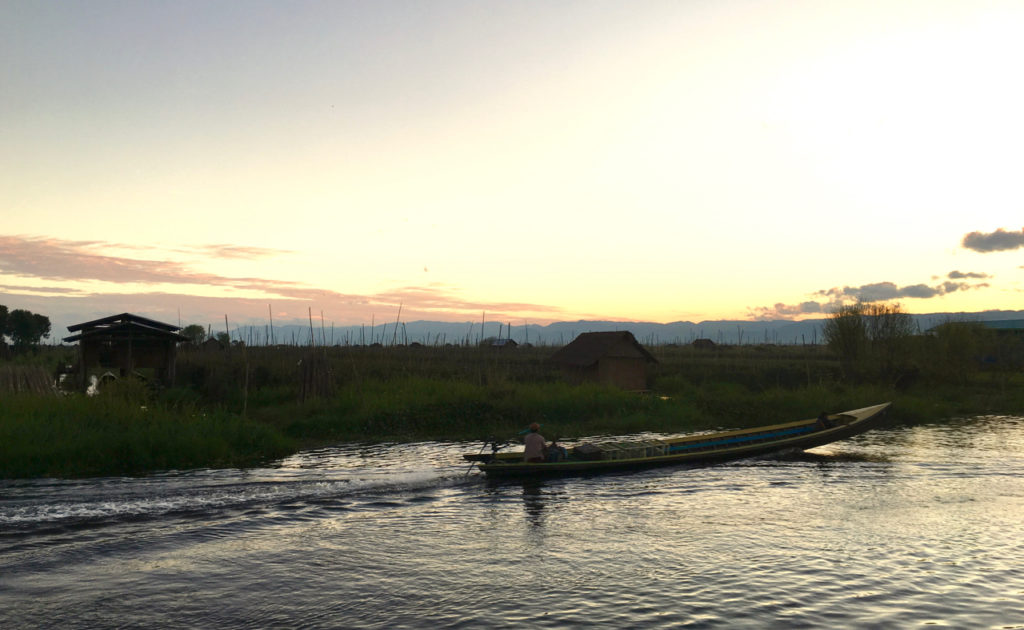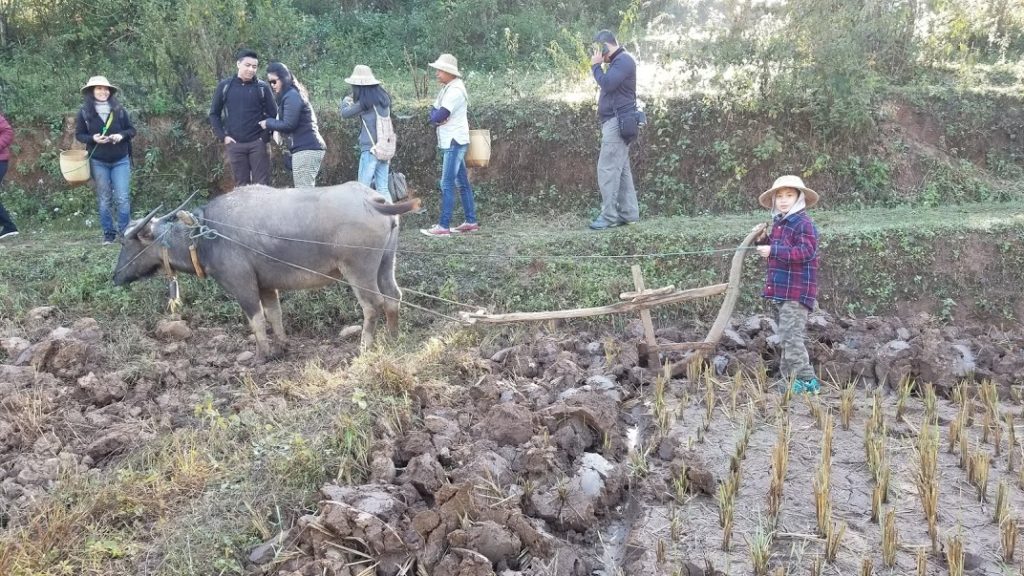| Duration 7 Days | Price On Request |
| Tour Set Family Travel | Tour Guide English Speaking |
| Tour Size Small Group | Tour Type Family |
Taking part in this Around Inle with Family trip, you will be mesmerized by the breathtaking scenery around the marvelous Inle Lake home to the famous one-leg rowers. Kalaw is a popular place for families who love the cool weather and colonial feel of the town. The town is peaceful and colourful with own home gardens.

Inle Lake is set in the heart of the vast Shan State and ringed by hazy mountain ranges. The ambience with the shallow waters of the lake is one of Myanmar’s most magnificent scenic and cultural attractions. The hills surrounding the lake are a melting pot of culture and are inhabited by over 30 ethnic groups. Of these, the Inthar, are perhaps the best known.
Travel Journal by Ms Nandar from USA
Kalaw! Stayed at Hotel Kalaw Hill Lodge. They provide quite a unique experience of morning guided-hiking around hotel grounds. Walked through Crops and Paddy fields, Myo and Kids tried Buffalo-pulled plowing (may be back-up career consideration) and kids tried milking a cow (for few drops), then held a baby goat after feeding adults. Then a Bull Cart ride, around hotel on a set route. It was pretty full farm experience for City-Dwellers.
Kalaw Station is a must-go when in Town. They have Book Stations in many public places now (saw at Airports too) but sadly, no one seems to bother picking up and reading one.
Stopped at Myin Ma Hteet Cave on our way out of Kalaw to Aung Ban. Much less popular than Pindaya, it was not crowded with a gazillion people, even felt a bit scared to be alone at times.
Trip to Pinndaya! We drove by Ox market, stopped on a Pan-Hnan field (those little yellow flowers will mature into sesame seeds and locals produce cooking oil from them). Stopped at Traditional Umbrella production where everything is man-powered (no motor or any other type of power what-so-ever). Inside Pinndaya Cave, Myo and Tristan went a bit further beyond “End of Cave” sign. Tristan enjoyed riding Horse at Large compound with HUGE Banyan trees.
Start your first day in Yangon by heading over to the downtown and the ancient octagonal-shaped Sule Paya located in the very centre of Yangon. It is surrounded by the busy streets and colonial buildings such as the Supreme Court and Yangon City Hall.
Continue to the Botahtaung Pagoda close to the Yangon Jetty. There is a sort of mirrored maze inside the stupa, with glass showcases containing many of the ancient relics.
Stop by a street café to take a taste of the delicious local Shan noodle dish accompanied with some spring rolls and Shan tofu for filling lunch.
Afternoon visit is the vibrant Bogyoke (Scott) Market which has the largest selection of Burmese handicrafts.
In the evening, visit the Shwedagon Pagoda, the 'heart' of Buddhists in Myanmar. The Pagoda is believed to be 2,600 years old and there are always crowed with many people praying and making offerings at Shwedagon especially on Full Moon days and religious days.
criptionStart with a visit to Aye Thar Yar Wine Vineyard, where grapes are being cultivated and grape wine is being produced. Covering an area of 25 acres, the vine yard is situated on a hill, 1,300 meters above sea level. In the vine yard 7 species of grape are planted for making Red wine. They are Shiraz (Syrah), Cabernet Sauvignon, Tampranillo, Babera, Egiodola and Dornkelfelder. For producing White wine, 3 species of grape, Sauvignon Blanc, Semillon Blanc and Chemin Blanc have been grown. The panorama view is inviting while tasting the best quality wine and delicious meal. Walking along the vine yard is enjoyable and ranges of surrounding mountains and the vine yard background is worth photographed.
Then continue to Taunggyi which located stunning on a mountain point, for your exploration around Inle Lake. Panoramic views of the entire city, and further across the plains to the north of Lake Inle can be found at the Shwe Phone Pwint Pagoda, which sits at the hill side of East Taunggyi. It is the capital of Shan State and home to a large number of ethnic tribes. Interestingly, Shans are not in the majority, instead the Inthar and Pa-O groups are most populous here. This is best seen by a visit to the bustling market, which, popular every day, is at its best every five days when a travelling market comes to town and is frequented by the areas many ethnic groups, all kitted out in their colourful towels that the Pa-O women wear on their heads. Taunggyi’s greatest draw is the annual three day hot-air balloon festival, which draws thousands of visitors from across the country. The spectacle of hundreds of balloons in all kinds of different shapes and colours flying to the sky is a huge impression on the viewers.
In the evening drive down into the valley to Nyaung Shwe, continue to a beautifully designed bamboo restaurant called La Riziere Buvette which is on the way to Khaung Daing hot springs. It is located in the middle of Paddy Fields, all open kitchen and terraces facing to the rice fields and an incredible view of the mountains and the lake. Shan traditional food and drinks can be enjoyed at this cozy and charming place which provides fully fresh air and cool vibe. A stunning sunset view from the place can also be relished.
Start with a sightseeing by boat on the beautiful Inle Lake which is home to Inthar national race, many of whom live in stilted houses built over the water. Inle Lake is the second largest lake in Myanmar, stretches 11 miles (17.7 km). It is mesmerizing to see the leg rowers casting over the conical fishing net on the glistening lake while balancing on one leg on the wooden boat. The other leg is wrapped around the long single paddle which tucked neatly under the arm. Observing and photographing with awe at the leg-rowers putting on the right amount of pressure on the free leg, while their other leg steers, turns and uses the paddle to slow the boat down is always occurred.
The boat trip will continue along the tangles of the water hyacinth leaves and floating gardens.
The unique floating islands are tethered by the bundles of weeds, mud and bamboo poles. Inthars living on the lake harvest three crops of tomatoes, eggplants, other fruits and vegetables every year. They sell their produce which grow on these highly-nutritious gardens at the 5-day markets in towns and villages around the lake.
Next stop is to see Lotus Silk Weaving at one of the lotus, silk and cotton hand-weaving shops. Kyaing Khan and In Paw Khone villages are the main ones which have many weaving shops. The shops have a live demonstration of the lotus weaving process by using all hands and traditional tools. The first step is cutting lotus stems into small pieces and extracting silky filament. The second step is to produce a single fine thread by moistening the fibers and rolling them together. About 4000 lotus stems to be used and a day spent for one scarf. The next step is spinning the fresh lotus threads into reels by a hand-made wheel. Finally the scarfs, bags and clothes are made by using the old hand looms.
Stop by Inthar Heritage House for delicious Inthar lunch. The restaurant serves up authentic Inthar food on a veranda overlooking the lush Shan hills. Fish, turmeric and the rice powder are the main players of traditional Inthar cuisine. At Inthar Heritage House, the fresh vegetables are gown in their own organic garden. There are interesting local dish such as banana flower salad with lime and basil, or spring onion fritters. Stuffed Fish or rice power with spring onion wraps are very popular dishes. The fish is marinated with salt, lemon juice and turmeric; and stuffed with fried ginger, lemongrass, tomato, chilli, garlic and coriander. After being tied with strings and fried, the famous Inle stuffed fish dish is ready to savour.
After lunch, it is the bonding time with the Burmese Cats from Inthar Heritage. The pure-bred cats are brought back from UK and Australia to stay back in their original land. Traditional Inthar art, culture and architecture will be learned through touring around the house, library and souvenir shop. The heritage house is designed and built by the inspiration of Inthar culture.
In the afternoon, visit the very famous Phaung Daw Oo Pagoda which is one of the sacred sites in Shan region. Seeing the huge religious building with the golden stupa on top glinted in the sunlight from afar is an amazing sentiment. Inside the center of the pagoda building is a decorative shrine with a stand, on which the five ancient golden Buddhas are kept. The Buddha images are over 800 year old and have been applied with so many gold leaves by the Buddhist devotees daily that it is impossible to see their original structure. The large golden barge, a replica of a royal barge of King Alung Sithu is kept next to the Paung Daw Oo Pagoda. The barge is used annually during the Phaung Daw Oo Pagoda festival to carry the four of the Buddhas and tour around over twenty villages towed by over fifty long boats, each with around forty leg-rowers, dancers and music performers.
The last stop for the day is the teak Nga Phe Kyaung (Cat jumping) Monastery, one of the oldest monasteries on the lake in which numerous huge ancient Buddha images are kept. The cats will still be found in the monastery but they no longer jump or entertain the visitors.
Start sightseeing one of the local five-day markets which rotate among the villages in regular order - one village becomes the host of the market every 5th day. Exploring these markets will lend insight into the life-style of the ethnic Pa-O, Danu and Inthar inhabitants, who come to these markets to tout their wares, from silverwares, jewllery, cotton scarfs, Shan style trousers and bags or sell their fresh produce grown by Inthar. You will be able to observe the customs and traditional dress of these various groups, a colourful sight to behold. Nampan and Indein five-day markets are the well-known ones.
Then proceed to the Indein pagoda complex - an archaeological site where hundreds of Shan-style pagoda ruins are situated on a sloping hill, some entirely hidden by vigorous bush and foliage and some of the pagodas dating back to 17th and 18th centuries. True to the meaning of Indein in Burmese which is shallow lake, the village is situated in the shallow part of the lake and some distance away from the main route.
Behind the Nyaung Oak (a group of Banyan trees) village, the first set of crumbling ancient pagodas are found. The stucco carvings of mythical animals, celestial beings and chinthe (mythical lion) can still be seen but mainly in destruction. After climbing along the stairway from Nyaung Oak, there is a second set of ruined ancient pagodas of Shwe Indein. The passageway is one of the longest in the whole Myanmar and filled with stalls selling handicrafts. The view from the top of Shwe Indein Pagoda is breathtaking.
This morning, proceed to Pindaya which is famous for the limestone caves, the peaceful lakeside set, and the beautiful centuries-old gigantic Bangyan trees. Inside the famous Pindaya Cave, it is believed to contain more than 8000 Buddha Images of all sizes in wood, stone, marble and bronze thickly glided. At the entrance to the caves sits the 15 metre tall Shwe U Min Pagoda. The caves are set deep and extends almost 500 feet deep into the hillsides. The traditional oiled paper umbrellas that used by monks and nuns are manufactured around here in Pindaya. Shan papers production workshops are also there to observe how the handmade papers are produced from the pulp of mulberry bark dried in the sun.
Daily activities at Kalaw Hill Lodge. Fly to Yangon in the evening.
Say goodbye to your guide to depart Yangon. Take sweet memories of family bonding and travelling together in Myanmar back home. En Route will always make the unforgettable travel experience that lasts a life time.
It is fun joining the activities that can create a precious memories together with family at the Kalaw Hill Lodge. At the organic farm where a large variety of vegetables are grown, you can learn the technique of growing them traditionally by joining the farmer to learn planting, treating and harvesting process. Farming within the lodge with buffalo is a really fun experience. Here you can experience how these buffalos and human form a partnership in terms of working and safeguarding the environment. Milking a cow also could be of a real-life experience. You never know when you might need to be able to milk a cow. In reality it gives a warmth touch and you are communicating with the cow touching with the hearts.

Enquire to tailor your own private tour to discover Myanmar which is a mixed of past and modern world.










